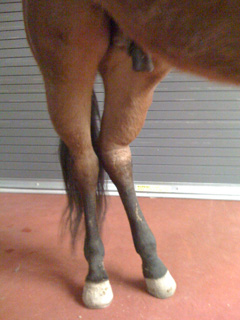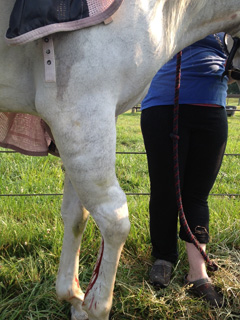If you suspect your horse has a fracture, call your primary care veterinarian immediately. While waiting for your veterinarian, it is best to attempt to keep your horse as quiet and calm as possible. Your veterinarian may take radiographs in the field (depending on the suspected fracture location) and then place a bandage with a splint or a cast. Many types of fractures in horses can be repaired; however, some cannot. Once appropriate first aid is given ask your veterinarian to consult an ACVS board-certified veterinary surgeon to determine if your horse’s fracture can be repaired and what additional measures need to be taken.
- Not bearing any weight on the limb or extreme lameness (i.e., toe-touching, hopping, or dragging the limb)
- Signs of shock: Sweating, anxiousness, elevated heart rate (normal heart rate for horses is 48 beats per minute or less)
- +/- Abnormal contour, angle, or shape of the limb (Figure 1)
- +/- Swelling around the area that is fractured (not always evident; Figure 1 and 2)
- +/- Bleeding if there is an associated laceration (if the fracture is open, Figure 2)


If you suspect your horse has a fracture, call your veterinarian immediately. They can give you specific instructions on what to do until they arrive. Upon arrival, they may diagnose the fracture on physical exam, or they may need to take radiographs. In some instances if a fracture is suspected but cannot be found at your farm, your veterinarian may recommend you take your horse to a referral center for advanced diagnostics such as digital radiographs, ultrasound, nuclear scintigraphy (“bone scan”), or computed tomography (CT).
It is extremely important that the fractured limb be stabilized as quickly as possible. Always consult with a veterinarian before proceeding to treat or stabilize your horse. Horses with open or “compound” fractures have a much poorer prognosis for survival than those with closed fractures where the skin hasn’t been broken. Knowing how to quickly stabilize the limb can prevent closed fractures from becoming open fractures due to the horse’s movement or repeated attempts to bear weight on the limb. Having a pre-made first aid kit for emergencies may be helpful. Such a kit might include sedation, phenylbutazone or banamine, bandaging supplies, scissors, duct tape and materials to use as splints.
Your veterinarian will immediately immobilize the fractured site with a bandage and splint and attempt to keep the horse quiet. The splint that is placed may extend the full limb or it may be half limb, depending on the site of the fracture. Your veterinarian may also decide to place more than one splint (usually placed at 90 degrees to each other) based on the fracture location (see Figures 3 and 4).
- Do not move your horse until the limb is adequately stabilized.
- A poorly placed splint can do more harm than good! It can weigh down the limb and also put pressure on the fracture itself, causing both increased soft tissue and bone damage. If your veterinarian has directed you to place the splint, make sure you are applying it as recommended depending on the suspected fracture site.
- Pain relief may be provided with non-steroidal anti-inflammatory drugs (phenylbutazone or banamine); consult your veterinarian before administering any medications to your horse.
Splints can be made from a variety of materials, including PVC pipe (halved or cut in thirds lengthwise works very well), broom handles, or small boards. Using 2×4 boards has also been recommended; however, consult with your veterinarian first as these boards can be quite heavy and potentially cause more damage to the limb. If your horse is extremely distressed, it may be necessary to sedate them. Use the lowest possible dose of sedation; too much sedation can compromise coordination, resulting in greater damage as the horse moves around or stumbles. If there is an open wound it should be quickly cleaned with water and bandaged to protect it from further contamination. Do not apply ointments or other topical medications before your veterinarian can assess the injury. If bleeding is excessive, control it by direct pressure over the wound. A pressure bandage should be applied before splinting is attempted.


Once the fracture has been temporarily stabilized and the bone that is fractured is diagnosed, the next step is to consider the options for treatment and determine whether your horse is a candidate for fracture repair. The main factors that should be considered are:
- Location of the fracture
- Size of the horse
- Open vs. closed fracture
- Severity of the fracture
- Condition and temperament of the horse
- Cost of treatment
- Expectations for outcome (i.e. return to full use vs. pasture sound
Small horses or foals (less than 700 lbs) with closed, simple fractures have the best overall chance for survival. Large horses with highly fragmented open fractures or fractures of the upper limb have a poor prognosis for survival. Horses that have lost blood supply to the limb should be humanely euthanized. Fracture repair in horses is extremely challenging and should only be attempted by an experienced ACVS board-certified veterinary surgeon in an appropriately equipped facility. There are numerous factors specific to each type of fracture and each individual horse.












